How Big Does a Black Red Tailed Shark Get
It's A Fish Thing is reader-supported. When you buy via links on our site, we may earn an affiliate commission at no cost to you. Learn more.
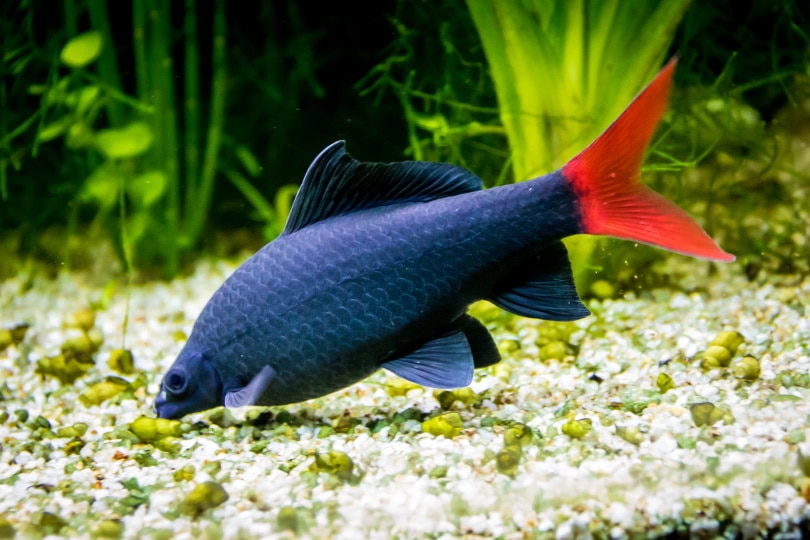
Red-tailed sharks are a type of tropical, freshwater fish that have an aggressive and territorial temperament. They have a black body with a dark ruby red tail fin. They are a form of suckermouth fish that spends most of their time cleaning away at surfaces in the tank. They form part of the aquarium's clean-up crew and feed off algae and leftover fish food. Aside from their aggressive nature, they can do well in large community tanks with tank mates that swim near the mid or top level of the aquarium. Red-tailed sharks should be kept alone in an aquarium without other red or rainbow-tailed sharks due to their territorial nature.
This article will help inform you on suitable tank mates for red-tailed sharks and how to successfully keep them with other fish in a community tank.
Table of contents
- 10 Best Tank Mates for Red-Tailed Sharks in 2021
- 1. Mollies
- 2. Danios – Best for Small Tanks
- 3. Neon Tetras
- 4. Platies
- 5. Swordtails
- 6. Freshwater Snails (Apple or Mysteries)
- 7. GMO Tetras
- 8. Dwarf Gourami
- 9. Bala Sharks
- 10. Rasbora
- What Makes a Good Tank Mate for Red-Tailed Sharks?
- Where Do Red-Tailed Sharks Prefer to Live in the Aquarium?
- Water Parameters
- Size
- Aggressive Behavior
- Benefits of Having Tank Mates for Red-Tailed Sharks in Your Aquarium
- How to Successfully Keep Red-Tailed Sharks with Other Fish
- Conclusion
10 Best Tank Mates for Red-Tailed Sharks in 2021
1. Mollies

- Size: 2-3 inches
- Diet: Omnivore
- Minimum tank size: 20 gallons
- Care Level: Easy
- Temperament: Playful
Mollies are colorful and playful tropical fish that can live with a red-tailed shark in a large community tank. They are large enough that they do not fit into a red-tailed shark's mouth and become a quick meal. Mollies commonly feed on algae in a tank which can pose a problem if they are consuming the red-tailed sharks' primary grazing food. You should provide them with sinking algae pellets to incorporate algae into both the mollies and red-tailed sharks' diet. Mollies should be kept in groups of 5 or more to be content.
Related Read: How Big Do Mollies Get: Size Guide
2. Danios – Best for Small Tanks
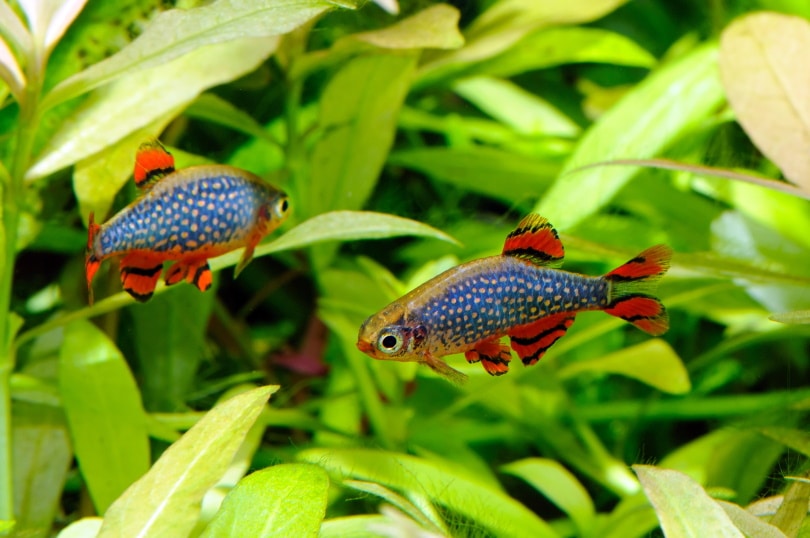
- Size: 1-1.5 inches
- Diet: Omnivore
- Minimum tank size: 10 gallons
- Care Level: Easy
- Temperament: Peaceful shoaling fish
Danios are small colorful shoaling fish that are small enough to fit into a smaller tank setup for red-tailed sharks. They need to be in schools of 6 or more and will do poorly if they are kept in smaller groups. They seem to swim near the top of the tank and should rarely interact with the red-tailed shark.
3. Neon Tetras
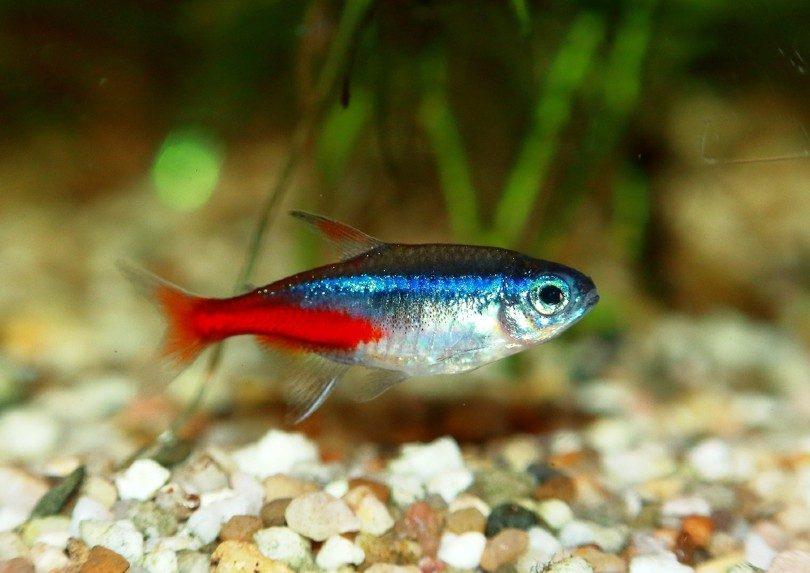
- Size: 1-1.5 inches
- Diet: Omnivore
- Minimum tank size: 10 gallons
- Care Level: Easy
- Temperament: Peaceful shoaling fish
Neon tetras are classic shoaling fish with vivid blue and green colors. They should be in groups of 8 or more to form an appropriate shoal. Neon tetras are peaceful community fish that form a centerpiece in the tank. Red-tail sharks will barely notice the neon tetras in the tank as long as all the inhabitants have plenty of hiding spaces.
4. Platies

- Size: 2 to 3.5 inches
- Diet: Omnivore
- Minimum tank size: 20 gallons
- Care Level: Easy
- Temperament: Playful
Platies are like mollies in terms of care and tank size. They have similar requirements and can even be kept with mollies and other small shoaling fish. Platys have a sleeker body with a more prominent tail, and they come in a variety of colors and patterns. Platys are playful fish that do well in large groups of other livebearers. They will rarely bother with red-tailed sharks, but it is not uncommon for the shark to briefly chase them if they come too close.
5. Swordtails

- Size: 2-4 inches
- Diet: Omnivore
- Minimum tank size: 20 gallons
- Care Level: Easy
- Temperament: Shy
Swordtails are another type of livebearer that is like both mollies and platies. They have a long and pointed tail that differs from platies and mollies who have standard-shaped tails. Swordtails are shy fish that will seek shelter amongst bushy live plants like hornwort or java moss. Their timid nature goes unnoticed by most red-tailed sharks.
6. Freshwater Snails (Apple or Mysteries)
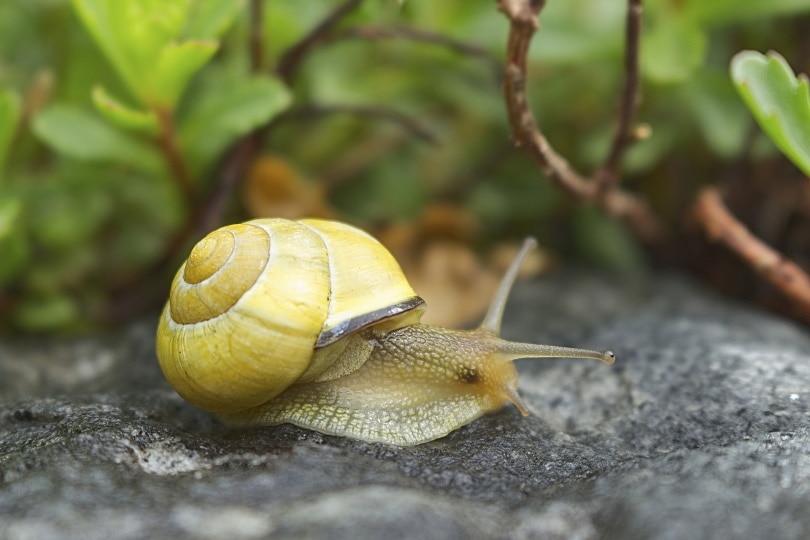
- Size: 2 to 4 inches
- Diet: Omnivore
- Minimum tank size: 15 gallons
- Care Level: Easy
- Temperament: Peaceful
Freshwater snails like apple and mystery snails are some of the best invertebrates to keep with red-tailed sharks. They grow significantly larger than other types of snails like nerites and ramshorn snails. Red-tailed sharks will not pay much attention to snails of all sizes if there are enough hiding places and plants for the snails.
7. GMO Tetras

- Size: 2-3.5 inches
- Diet: Omnivore
- Minimum tank size: 20 gallons
- Care Level: Easy
- Temperament: Community shoaling fish
If you are interested in keeping a colorful, yet large growing tetra, then the GMO tetra will work for a large tank with a red-tailed shark. They are fast swimmers that can easily avoid red-tailed sharks in the same tank. They should be kept in pairs of 4 or more to form a small shoal. They are great community fish and can be housed with other fish on the list such as neon tetras or danios.
8. Dwarf Gourami
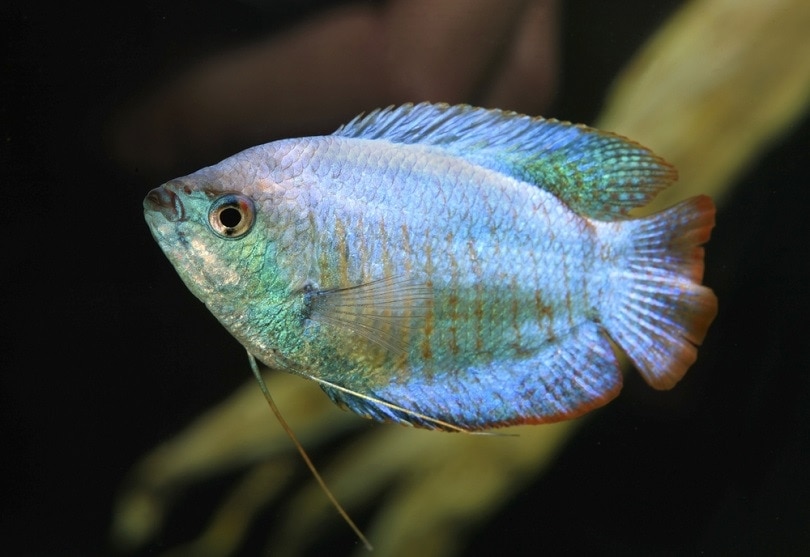
- Size: 2-5 inches
- Diet: Omnivore
- Minimum tank size: 20 gallons
- Care Level: Moderate
- Temperament: Community
A male and female dwarf gourami can work as a pair that consists of a male and female. They are striking fish that come in vibrant colors. They make great community fish but also work as a lonesome pair with a red-tailed shark. Dwarf gourami is peaceful community fish that a red-tailed shark will tolerate.
9. Bala Sharks

- Size: 6-8 inches
- Diet: Carnivore
- Minimum tank size: 40 gallons
- Care Level: Moderate
- Temperament: Shoaling fish
Bala sharks are a much larger type of shoaling fish that should be kept in pairs or more. They are generally peaceful fish that grow larger than a red-tailed shark does. Bala sharks are shy and show minimal aggression if they are kept in appropriately sized groups. However, ensure that you house Bala sharks with an adult red-tailed shark so that they do not eat the young ones who are much smaller.
10. Rasbora

- Size: 2-3.5 inches
- Diet: Omnivore
- Minimum tank size: 15 gallons
- Care Level: Easy
- Temperament: Community
These small shoaling fish are great in community tanks with a red-tailed shark and other types of small fish. They do not typically bother with red-tailed sharks and will swim around the middle level of the tank. Rasboras are easy to care for which allows for you to put more effort into caring for your red-tailed shark.

What Makes a Good Tank Mate for Red-Tailed Sharks?
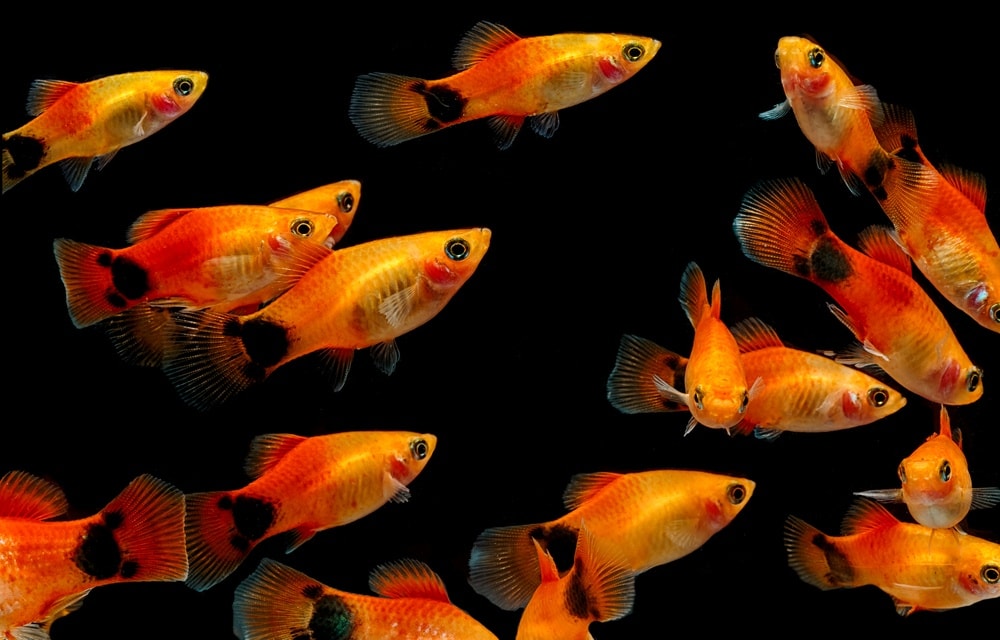
Livebearers like mollies, platies, and swordtails are one of the best fish tank mates to keep with a red-tailed shark. When it comes to invertebrates, freshwater snails can be successfully kept with red-tailed sharks at both a small and an adult size. You can also mix most of the tank mates. Livebearers get along well with tetras and danios.
Where Do Red-Tailed Sharks Prefer to Live in the Aquarium?
The red-tailed shark will primarily inhabit the lower level of the tank. They enjoy hanging out near driftwood and amongst live plants. Red-tailed sharks do not swim freely as most fish do, instead, they hover over surfaces and start sucking any algae from them. Red-tailed sharks may swim to the top to gulp air if there is improper surface agitation for oxygen to enter the water column.
Water Parameters
The water parameters should be kept within the ideal levels. Red-tailed sharks are not particularly sensitive to high levels of nitrite, but the water should still be kept clean using a filter and regular water changes. Only place the red-tailed shark in the tank if the tank has been fully cycled for 4 to 6 weeks prior.
Size
Red-tailed sharks grow slowly and reach adult sizes between 5 to 7 inches. Due to their size, they require a large tank with the starting minimum being 20 gallons for one red-tailed shark and a pair of gourami or snails. If you plan to keep shoaling fish with your shark, a 25-gallon tank or larger is recommended.

Aggressive Behavior
Red-tails territorial nature is what causes them to act aggressively. They protect their established territory that usually consists of a small portion of the tank. Their territory is typically near a cave-like structure and plants. When another fish tries to swim into their territory, red-tailed sharks will chase or nip at the fish. This makes it important to keep fast-moving fish that can swim away when the red-tailed shark decides to act aggressively.

Benefits of Having Tank Mates for Red-Tailed Sharks in Your Aquarium
- Tankmates can help a red-tailed shark to get used to having other fish in the tank and lower their aggression. Community tanks will promote a balanced ecosystem where all the inhabitants learn to be kept together.
- A colorful and interesting collection of fish in the tank can be created by choosing fish that have similarly toned colors as the striking red and black red-tailed shark.
How to Successfully Keep Red-Tailed Sharks with Other Fish

If you want to balance out your red-tailed sharks with other fish in a community tank, then you should ensure that you are meeting the needs of each fish in the tank. When every fish is well cared for and fed a high-quality diet, then they will display lower aggression levels that are commonly triggered by stress. Both red-tailed sharks and their tank mates thrive in a heavily planted tank that consists of a variety of live plants with different rocks and pieces of driftwood. Hideouts for fish are commonly sold in pet stores and allow your red-tailed shark to have a safe retreat.
Related Read: Rainbow Shark Tank Mates: Best 8 Companions

Conclusion
Even though red-tailed sharks have a few compatible tank mates, it does not guarantee that there will be no fights or injuries when they are being kept together. Compatible tank mates only limit the number of potential fights that could happen with unsuitable tank mates. Always ensure that you cycle the tank before placing your red-tailed shark and the chosen tank mates in the tank to avoid excess stress and shock from unstable water parameters. This way you will have a higher success rate of keeping your shark with other types of fish.
Featured Image Credit: Diego Grandi, Shutterstock
How Big Does a Black Red Tailed Shark Get
Source: https://www.itsafishthing.com/best-tank-mates-for-red-tailed-sharks/